My grandfather gave me my first pocket knife at 8 years old and taught me to sharpen it. Each time he’d visit he’d check the edge, if it wasn’t sharp he wouldn’t say anything but he’d take it, sharpen it, and return it to me. He used to say the only thing a dull knife was good for was spreading butter.
It took me a long time to get good at sharpening. I believe what makes it easier to sharpen a knife is to have the right sharpener. Many years ago I went on a ‘quest’ to find the best knife sharper.
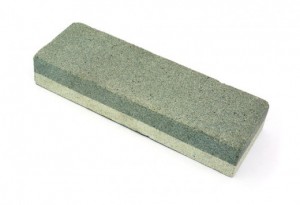 There are many styles out there. The traditional whetstone is the standard. Incidentally “whet” means to sharpen a blade (not wet as in a reference to using it lubricated). Natural whetstones have long been used throughout history, but because of their rarity have become more expensive, and their grain is inconsistent. Today most are artificially made, resulting in a less expensive product, with a consistent grain. Many now are double-sided with a coarser side* and a finer side. Whetstones can be used dry, or wetted with oil or water which reduces resistance for a finer edge. My grandfather always had a large fine whetstone sitting on his desk and another coarser one with the tools (and frequently a smaller one in his pocket). The disadvantage of a whetstone is that the lower density material gets shaved off, over time, during sharpening; this causes the stone to become misshapen, or curved instead of flat. When this happens, it must be reshaped so it can again correctly sharpen a blade.
There are many styles out there. The traditional whetstone is the standard. Incidentally “whet” means to sharpen a blade (not wet as in a reference to using it lubricated). Natural whetstones have long been used throughout history, but because of their rarity have become more expensive, and their grain is inconsistent. Today most are artificially made, resulting in a less expensive product, with a consistent grain. Many now are double-sided with a coarser side* and a finer side. Whetstones can be used dry, or wetted with oil or water which reduces resistance for a finer edge. My grandfather always had a large fine whetstone sitting on his desk and another coarser one with the tools (and frequently a smaller one in his pocket). The disadvantage of a whetstone is that the lower density material gets shaved off, over time, during sharpening; this causes the stone to become misshapen, or curved instead of flat. When this happens, it must be reshaped so it can again correctly sharpen a blade.
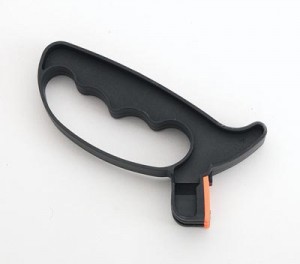
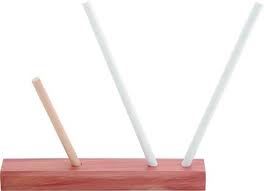 As I said, I’ve tried many of the sharpening stones/systems/tools out there. There are types that you mount the blade into and then the blade is kept at exactly the right angle; I don’t like them much, I’ve never had trouble holding the knife at the right angle and all the mounting stuff takes time and extra space and equipment. I also don’t care much for the ceramic rods sharpening system.; again they require setup and space and create the “exact” sharpening angle. There are also electrical sharpeners which are expensive but sharpen well and can even sharpen serrated knives. Also, there are relatively inexpensive ‘V’ style sharpeners that work fine. But using either of these last two, you never “learn” to sharpen a knife, which is an important skill-set for a prepper.
As I said, I’ve tried many of the sharpening stones/systems/tools out there. There are types that you mount the blade into and then the blade is kept at exactly the right angle; I don’t like them much, I’ve never had trouble holding the knife at the right angle and all the mounting stuff takes time and extra space and equipment. I also don’t care much for the ceramic rods sharpening system.; again they require setup and space and create the “exact” sharpening angle. There are also electrical sharpeners which are expensive but sharpen well and can even sharpen serrated knives. Also, there are relatively inexpensive ‘V’ style sharpeners that work fine. But using either of these last two, you never “learn” to sharpen a knife, which is an important skill-set for a prepper.
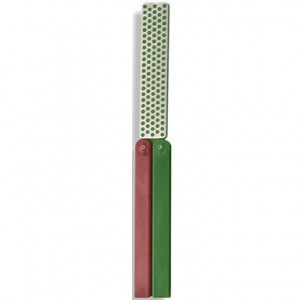 So what I use, and recommend, is a diamond plated stone. The surface is impregnated with diamond dust particles, which act as an abrasive to grind metal. They come in various sizes and grades of grit. They tend to be more expensive than artificial whetstones, but never become misshapen.
So what I use, and recommend, is a diamond plated stone. The surface is impregnated with diamond dust particles, which act as an abrasive to grind metal. They come in various sizes and grades of grit. They tend to be more expensive than artificial whetstones, but never become misshapen.
My favorite brand, though there are others, is DMT. I particularly like their folding models which are lightweight and compact (closed 5 inches long). They have a double-sided version that comes with a coarser side and a finer side (I buy the one that’s red: fine, and green: extra fine) they cost about $30. I also have one of their bench stones which is larger and is designed to be used with it sitting on a solid surface.
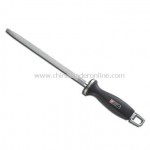 It’s also important to have a good honing steel (also referred to as a sharpening rod), especially for your kitchen knives. Honing re-aligns the blade whereas sharpening on a stone actually scrapes off a little of it, so you hone more often than sharpen (but honing does no good if the edge is blunt, because it removes no material). If you have a good set of kitchen knives that you use frequently you’d probably sharpen them on a stone every couple of months, but you should probably hone** them on a steel before each use.
It’s also important to have a good honing steel (also referred to as a sharpening rod), especially for your kitchen knives. Honing re-aligns the blade whereas sharpening on a stone actually scrapes off a little of it, so you hone more often than sharpen (but honing does no good if the edge is blunt, because it removes no material). If you have a good set of kitchen knives that you use frequently you’d probably sharpen them on a stone every couple of months, but you should probably hone** them on a steel before each use.
Monday (8/6/12) I’ll post Sharpening Knives, Part 2: Techniques and Tips For Sharpening
*A coarser grit is used to remove larger amounts of metal more rapidly, such as when forming an edge or restoring a damaged edge. A finer grit is used to refine an edge.
**Honing steels are more effective on knives with softer steel blades that sharpen quickly but where the edge can easily deform. A harder steel knife blade deforms very little and instead just needs to be touched up regularly on a whetstone.
(Friday: What We Did This Week To Prep)

Excellent write up Trace. I have been looking for a good instructional on sharpening, and what works best for sharpening. Looking forward to reading part 2.
Thanks John! I believe being able to sharpen your own knife, quickly and efficiently, is an important skill worth developing.
Next time you come to visit, please bring your knife sharpener. Mom
I’d be happy to.
Pingback: Sharpening Knives, Part 2: Actually Doing It | TraceMyPreps